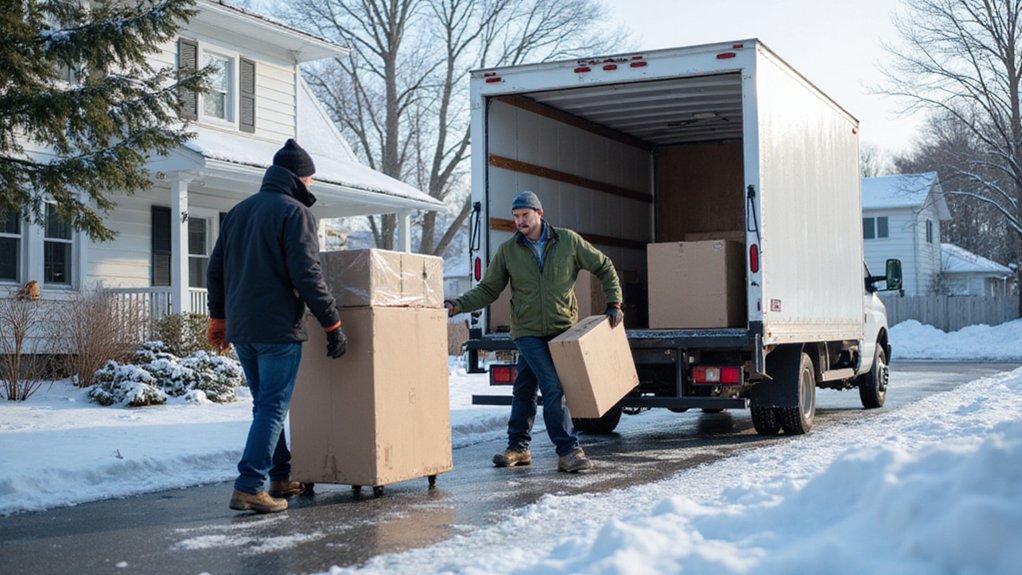Winter moving can feel overwhelming, but it doesn’t have to be a nightmare. You’ll face unique challenges when relocating during cold months, from protecting fragile items to traversing icy roads. Temperature fluctuations and potential snowstorms can complicate your shift, making careful planning essential. While the prospect might seem daunting, knowing the right strategies can metamorphose a potentially stressful move into a smooth, manageable experience. How will you guarantee your belongings and family stay safe during this chilly relocation?
Key Takeaways
- Prepare your moving vehicle with winter-specific maintenance, including checking tire pressure, battery health, and installing winter-grade windshield wipers.
- Protect fragile and temperature-sensitive belongings by using insulated containers, bubble wrap, and extra padding to prevent cold-weather damage.
- Prioritize personal safety by wearing layered, slip-resistant clothing and keeping walkways clear of snow and ice during moving day.
- Pack essential emergency supplies like blankets, extra food, and a first aid kit for unexpected winter travel challenges.
- Stay flexible with travel plans by consistently monitoring weather forecasts and road conditions during your winter relocation.
Preparing Your Moving Vehicle for Winter Conditions
How do you guarantee your moving vehicle remains safe and trustworthy during winter’s challenging conditions? Winterizing your vehicle starts with thorough cold weather maintenance.
Check your tire pressure, as cold temperatures can cause significant drops. Safeguard your battery is fully charged and replace it if it’s more than three years old.
Install winter-grade windshield wipers and keep your washer fluid topped up with a winter-specific solution. Pack emergency supplies like blankets, extra warm clothing, a snow shovel, and road salt.
Inspect your brakes, heater, and defroster to prevent unexpected breakdowns during your winter move. Consider Syracuse Moving Company’s professional services to help manage the complexities of a winter relocation.
Essential Winter Packing and Protection Strategies
When winter’s chill threatens to complicate your moving day, strategic packing and protection become your strongest allies.
Wrap fragile items in thick bubble wrap and use packing insulation to prevent damage from cold and potential impacts. Place temperature-sensitive belongings in insulated containers, keeping them away from exterior boxes. Layer your packed items with extra blankets or towels for added protection against freezing temperatures.
Seal boxes tightly to block moisture and cold, and mark fragile packages clearly. Your careful preparation will help guarantee your belongings arrive safely, despite winter’s challenging conditions. Consider hiring professional moving services with experience in handling delicate relocations during harsh winter weather.
Protecting Your Belongings From Cold Weather Damage
Cold weather poses significant risks to your personal belongings during a winter move, threatening damage through temperature fluctuations, moisture, and potential freezing conditions. To protect your items, consider these key strategies:
- Wrap fragile items in bubble wrap and insulating materials
- Use climate-controlled storage for temperature-sensitive electronics
- Pack electronics in original boxes with additional padding
- Safeguard delicate items by keeping them at consistent temperatures
Insulating delicate items prevents cracking and structural damage. By taking proactive steps, you’ll guarantee your belongings arrive safely, minimizing potential winter-related wear and preserving their condition throughout the move.
Safety Precautions for Winter Moving Day
Though winter moves can be challenging, prioritizing safety will help you traverse potential hazards and protect yourself during the relocation process. Wear proper attire with multiple layers, and choose slip resistant footwear to prevent dangerous falls on icy surfaces.
Keep walkways clear of snow and salt entry paths to minimize slipping risks. Stay alert and move slowly, watching for hidden ice patches near your home and moving truck.
Have a first aid kit readily available, and keep communication open with your moving team about potential weather-related challenges.
Managing Winter Road Travel During Relocation
If winter road conditions seem challenging, strategic planning can alter your moving expedition into a safer and more manageable experience. Consider these critical winter driving preparation steps:
- Check vehicle maintenance thoroughly before departure
- Pack emergency supplies like blankets and extra food
- Monitor weather forecasts and road conditions consistently
- Equip your vehicle with winter tires and safety equipment
Inclement weather impacts can dramatically change travel conditions, so remain flexible and patient. Your preparedness determines your success.
Handling Utilities and Home Transition in Cold Weather
Winter’s unique challenges demand careful utility and home shift planning during a move. You’ll want to coordinate utility transfers well in advance, ensuring electricity, water, and heating are active before you arrive. Contact your service providers at least two weeks prior to moving day, and schedule disconnection and reconnection times that minimize service interruptions.
Monitoring indoor climate becomes vital; have your new home’s heating system checked and insulated to maintain comfortable temperatures. Prepare backup heating options like space heaters or extra blankets, just in case unexpected issues arise during your relocation.
Special Considerations for Moving With Family and Pets
Moving with family and pets can quickly ramp up the complexity of a winter relocation. Consider these vital strategies:
- Pack children’s essential comfort items separately
- Create a warm, secure travel kit for pets
- Dress everyone in layers for temperature flexibility
- Prepare emergency warmth supplies for vehicle and destination
When keeping family warm, prioritize protective clothing and blankets. Caring for pets’ needs means ensuring they’re insulated, hydrated, and calm during transit.
Your furry companions require extra attention in cold conditions, so pack their favorite blankets and portable heaters. Minimize stress by maintaining familiar routines and comfort items throughout the moving process.
Frequently Asked Questions
How Much Extra Time Should I Budget for Winter Moving Logistics?
You’ll want to add 2-3 extra hours to your moving timeline. Bundling winter apparel and heating the moving truck can slow your pace, so plan flexibility and buffer time for unexpected cold-weather challenges.
Are Moving Costs Typically Higher During the Winter Months?
You’ll find moving costs are typically lower in winter due to reduced seasonal demand. Movers often offer discounts, giving you more flexibility and financial freedom during the off-peak moving season.
What Insurance Considerations Are Unique to Winter Moving Scenarios?
You’ll want extra liability insurance to cover weather-related damages during winter moves, protecting your belongings from potential cold-weather risks like water damage or breakage from freezing conditions.
Can Professional Movers Guarantee On-Time Arrival During Winter Conditions?
Professional movers can’t guarantee on-time arrival during winter’s unpredictable conditions. They’ll adjust with additional staffing and route flexibility, but you’ll need to be prepared for potential weather delays that are beyond their control.
How Do Winter Moves Impact Initial Rental or Home Setup?
Winter moves can interrupt your seasonal weather impacts, potentially delaying winter moving arrangements. You’ll need adaptable utility setups, backup power sources, and contingency plans to guarantee your home change remains stable despite unpredictable conditions.



